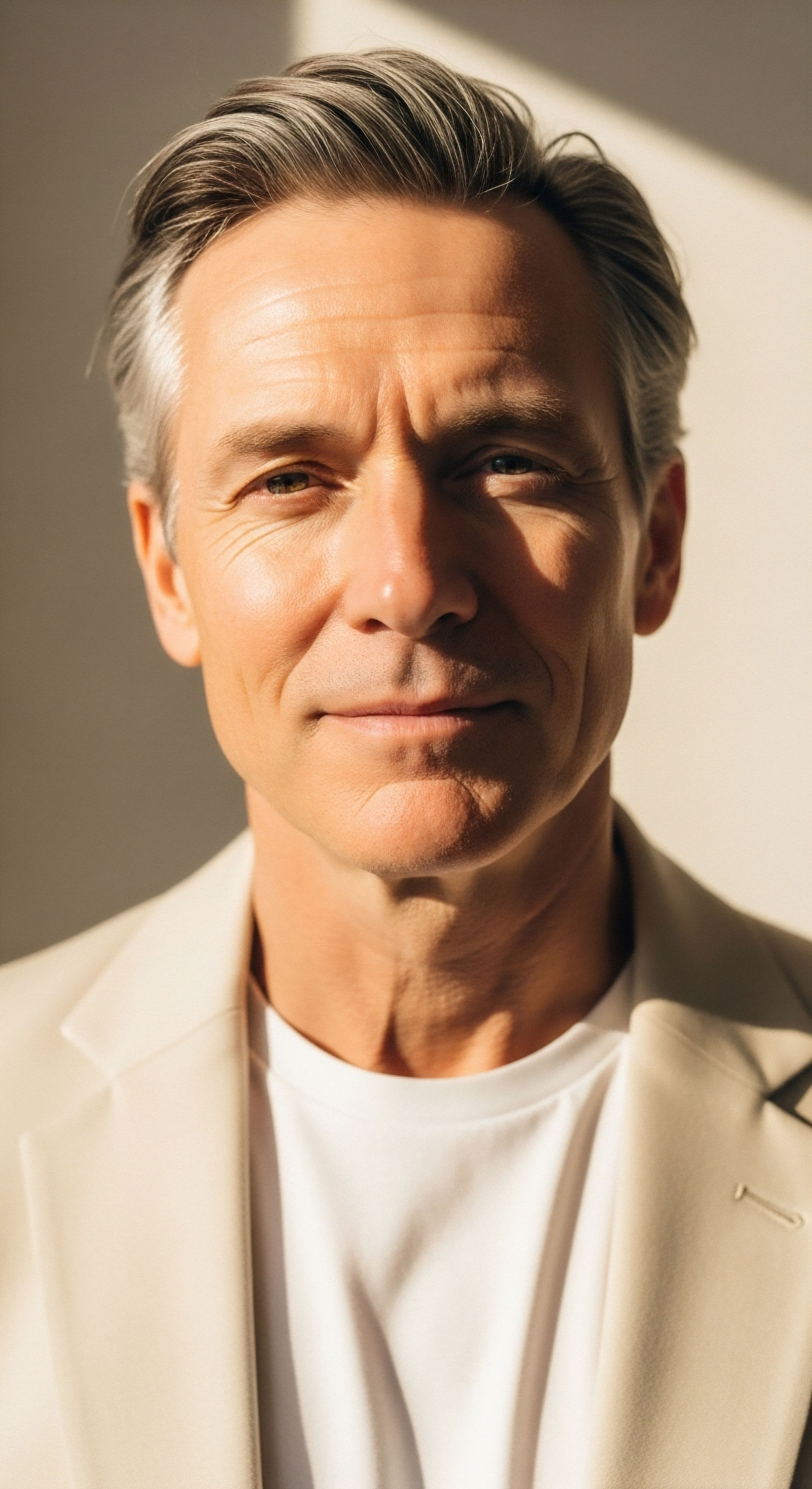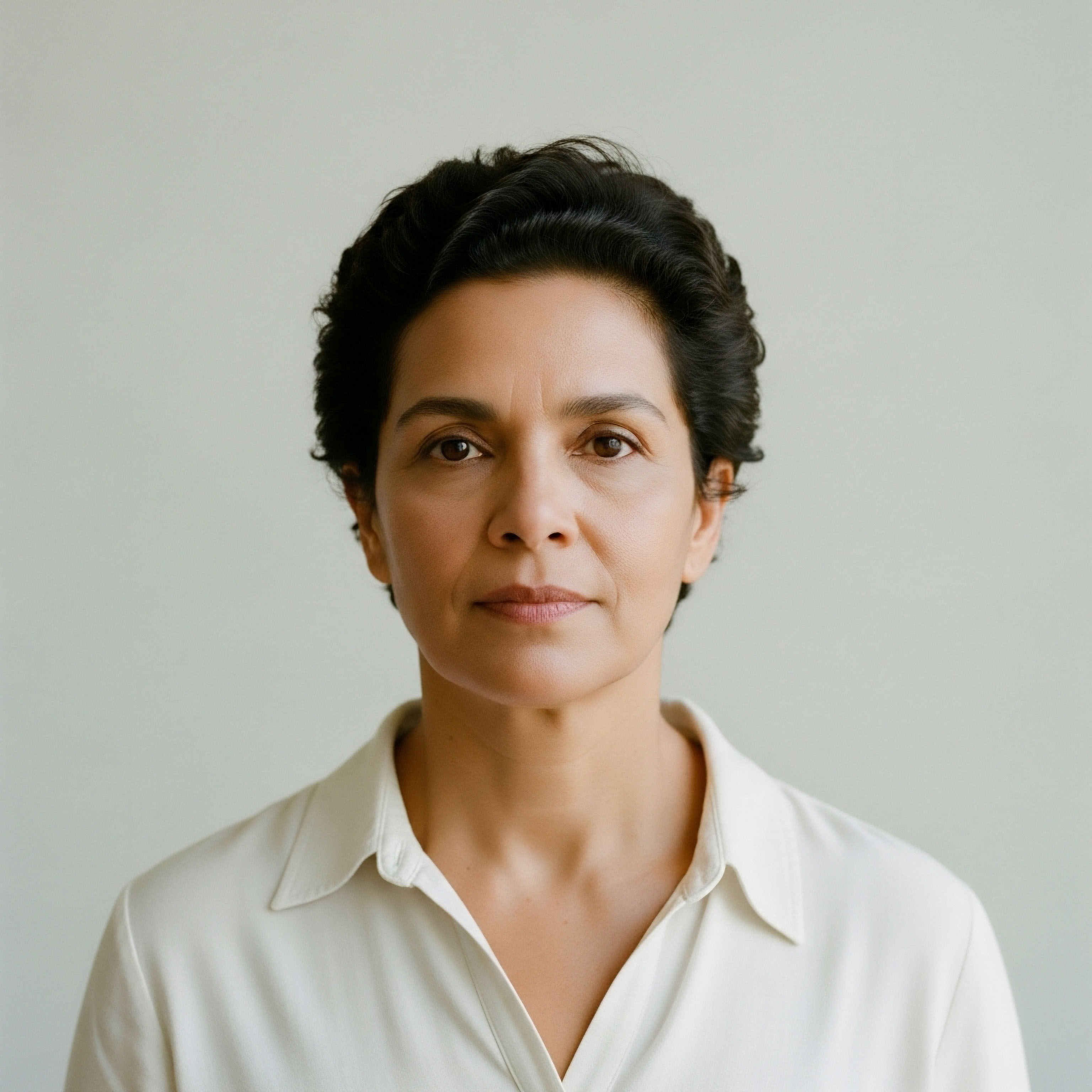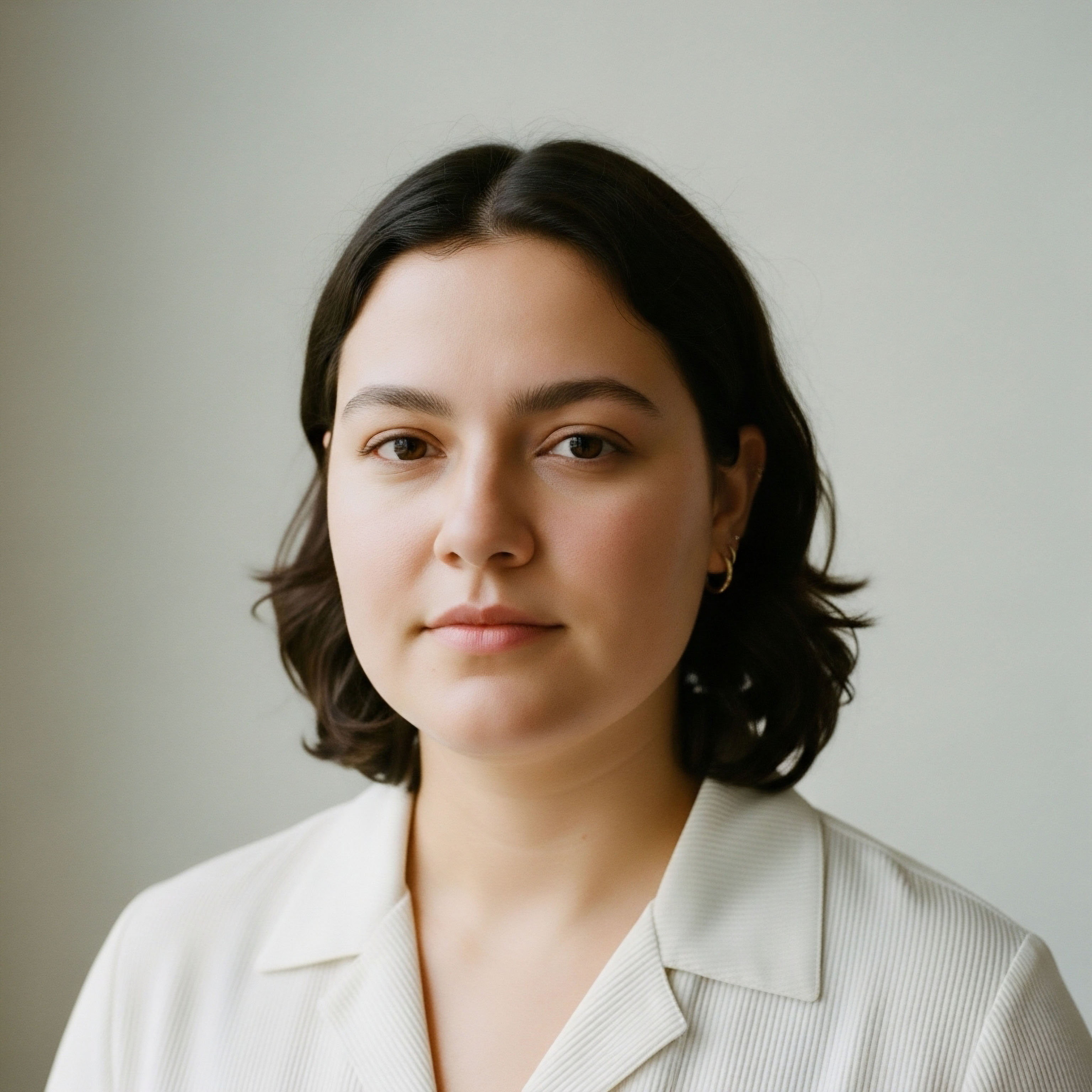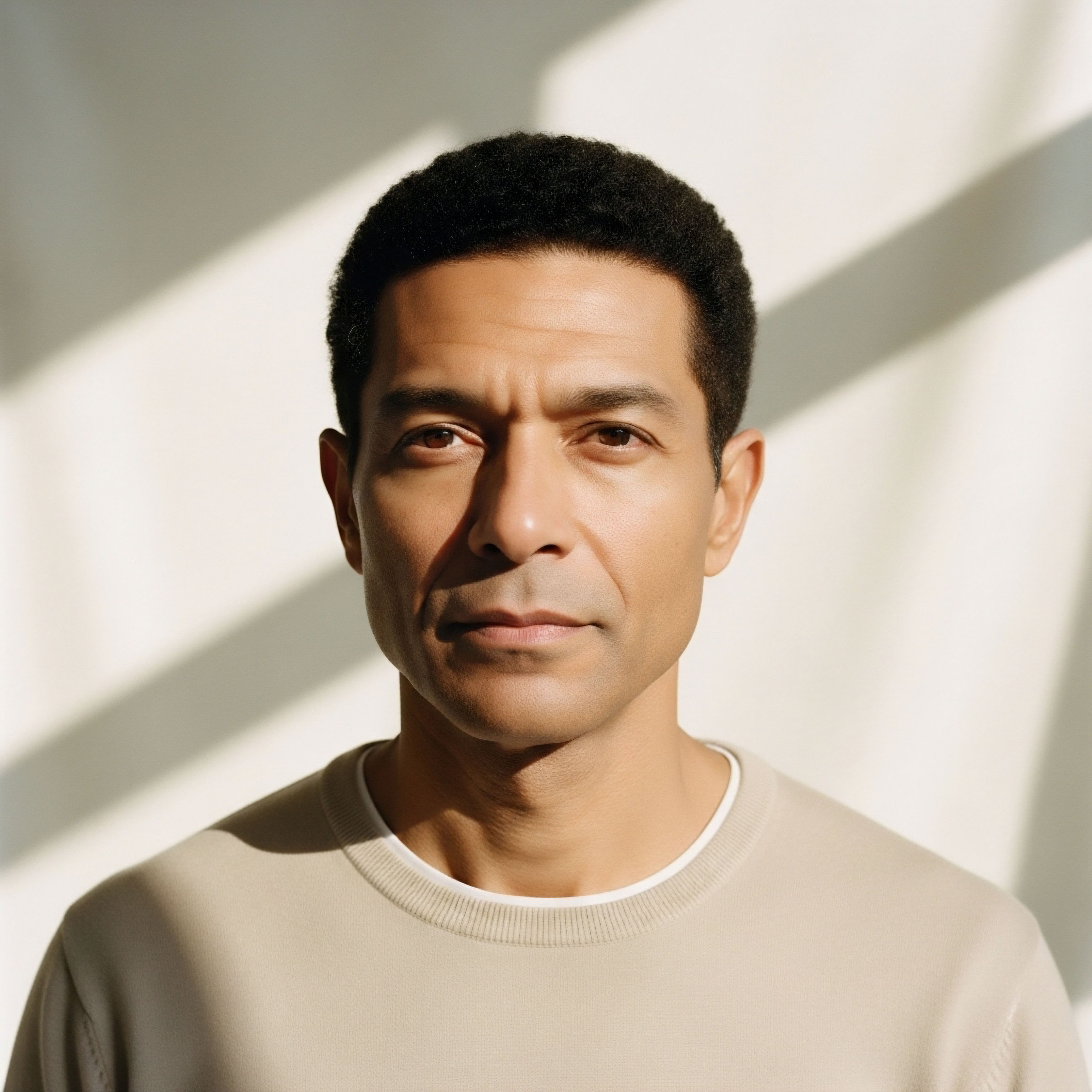

Fundamentals
Embarking on a protocol to optimize your hormonal health, such as Testosterone Replacement Therapy Meaning ∞ Testosterone Replacement Therapy (TRT) is a medical treatment for individuals with clinical hypogonadism. (TRT), often begins with a deeply personal recognition that your body’s internal systems are not functioning as they once did. You might feel a pervasive sense of fatigue, a decline in vitality, or a frustrating disconnect from your own sense of well-being. These experiences are valid and significant. They are the body’s way of signaling a disruption in its intricate communication network.
Understanding this network is the first step toward reclaiming your biological function. At the heart of male hormonal health lies a sophisticated and elegant system known as the Hypothalamic-Pituitary-Gonadal (HPG) axis. This axis is the command-and-control structure that governs testicular function, including testosterone and sperm production.
Imagine this system as a three-tiered corporate hierarchy. The hypothalamus, a specialized region in your brain, is the Chief Executive Officer (CEO). Its primary role is to monitor the body’s overall status and make high-level decisions. When it determines that more testosterone is needed, it doesn’t shout down to the factory floor.
Instead, it sends a precise, rhythmic memo every 90 to 120 minutes. This memo is a neuropeptide called Gonadotropin-Releasing Hormone (GnRH). This pulsatile release is a critical detail; the system is designed for communication in bursts, not a constant drone.
The GnRH Meaning ∞ Gonadotropin-releasing hormone, or GnRH, is a decapeptide produced by specialized neurosecretory cells within the hypothalamus of the brain. memo travels a short, direct route to the anterior pituitary gland, the system’s General Manager. The pituitary is highly responsive to these rhythmic pulses from the CEO. Upon receiving each GnRH signal, it releases its own set of instructions into the bloodstream. These instructions are two key hormones ∞ Luteinizing Hormone (LH) and Follicle-Stimulating Hormone (FSH).
LH is the primary signal for the testes to produce testosterone, while FSH Meaning ∞ Follicle-Stimulating Hormone (FSH) is a gonadotropin from the anterior pituitary, essential for reproduction. is central to stimulating sperm production. These hormones travel through the body’s circulatory system to reach their final destination ∞ the testes, which are the production factories of this operation.

The Consequence of External Inputs
When you begin TRT, you introduce testosterone from an external source. Your body, in its infinite wisdom and efficiency, detects these high levels of circulating testosterone. The CEO (hypothalamus) and General Manager (pituitary) see that the production quota is being met and exceeded. Their response is logical ∞ they cease sending their own signals.
The hypothalamus dramatically reduces its pulsatile release of GnRH, and consequently, the pituitary stops sending LH and FSH. This is a classic negative feedback Meaning ∞ Negative feedback describes a core biological control mechanism where a system’s output inhibits its own production, maintaining stability and equilibrium. loop, and it’s the reason TRT is so effective at raising blood testosterone levels. However, it also creates a significant challenge. The testes, deprived of their stimulating signals (LH and FSH), go dormant.
This leads to a reduction in their size and a shutdown of their dual functions ∞ producing endogenous testosterone and manufacturing sperm. This is the biological reality behind testicular atrophy Meaning ∞ Testicular atrophy refers to the clinical condition characterized by a measurable decrease in the size and volume of one or both testicles from their normal adult dimensions. and infertility associated with TRT. It is this very predictable outcome that necessitates a support strategy.
The introduction of external testosterone silences the natural hormonal conversation between the brain and the testes, leading to a functional shutdown of the gonads.

Two Distinct Tools for Testicular Support
To counteract this shutdown, clinical protocols Meaning ∞ Clinical protocols are systematic guidelines or standardized procedures guiding healthcare professionals to deliver consistent, evidence-based patient care for specific conditions. introduce agents designed to mimic the body’s natural signals. This is where Gonadorelin and Human Chorionic Gonadotropin Growth hormone modulators stimulate the body’s own GH production, often preserving natural pulsatility, while rhGH directly replaces the hormone. (HCG) enter the picture. They represent two fundamentally different strategies for reactivating the dormant testicular machinery.
Gonadorelin is a bioidentical form of GnRH, the CEO’s memo. By administering Gonadorelin, the goal is to replicate the natural, pulsatile signal from the hypothalamus to the pituitary. This prompts the pituitary (the General Manager) to wake up and resume its job of secreting LH and FSH, which then travel to the testes to stimulate them. It is an upstream intervention, designed to keep the entire HPG axis Meaning ∞ The HPG Axis, or Hypothalamic-Pituitary-Gonadal Axis, is a fundamental neuroendocrine pathway regulating human reproductive and sexual functions. communication pathway engaged, from the brain to the gonads.
Human Chorionic Gonadotropin (HCG), in contrast, is a direct-action hormone. It is a powerful mimic of Luteinizing Hormone Meaning ∞ Luteinizing Hormone, or LH, is a glycoprotein hormone synthesized and released by the anterior pituitary gland. (LH). Instead of signaling the pituitary, HCG bypasses the hypothalamus and pituitary altogether and travels directly to the LH receptors on the Leydig cells within the testes.
It essentially acts as a direct order to the factory floor, commanding the testes to produce testosterone and maintain their size and function, irrespective of the silence from the brain’s command centers. This makes it a very effective tool for preventing testicular atrophy during TRT.
Understanding these two compounds is foundational. Gonadorelin Meaning ∞ Gonadorelin is a synthetic decapeptide that is chemically and biologically identical to the naturally occurring gonadotropin-releasing hormone (GnRH). works from the top down, aiming to preserve the natural signaling cascade. HCG works from the bottom up, providing a direct and potent stimulus to the testes themselves. The question of whether these two distinct approaches can be used concurrently is a matter of deeper clinical strategy, weighing the benefits and potential conflicts of sending signals at two different levels of the same system.


Intermediate
For an individual engaged in a hormonal optimization protocol, understanding the fundamental roles of Gonadorelin and HCG Meaning ∞ Human Chorionic Gonadotropin, or HCG, is a glycoprotein hormone predominantly synthesized by the syncytiotrophoblast cells of the placenta during gestation. is the first layer. The next level of comprehension involves examining their clinical application, the specific mechanisms that make them effective, and the nuanced debate surrounding their concurrent use. The decision to use either agent, or both, is rooted in a sophisticated understanding of their pharmacodynamics—how they interact with the body’s receptors and signaling pathways over time.

A Deeper Look at the Mechanisms
When exogenous testosterone is introduced, the HPG axis suppression is profound. Studies have shown that in eugonadal men starting TRT, intratesticular testosterone Meaning ∞ Intratesticular testosterone refers to the androgen hormone testosterone that is synthesized and maintained at exceptionally high concentrations within the seminiferous tubules and interstitial spaces of the testes, crucial for local testicular function. can plummet by as much as 94%, creating an environment where spermatogenesis is severely impaired. This is the clinical problem that testicular support medications aim to solve. Both Gonadorelin and HCG address this, but their methods have different implications for the endocrine system.
- Gonadorelin’s Pulsatile Promise ∞ Gonadorelin is a synthetic analogue of Gonadotropin-Releasing Hormone (GnRH). Its clinical utility is entirely dependent on mimicking the natural, pulsatile secretion of GnRH from the hypothalamus. The pituitary gland is exquisitely sensitive to the frequency of GnRH signals. A pulsatile administration (often achieved through small, frequent subcutaneous injections) stimulates the gonadotroph cells in the pituitary to release LH and FSH. However, a continuous, non-pulsatile exposure to GnRH or its more potent agonists leads to the opposite effect ∞ it causes a downregulation and desensitization of the GnRH receptors on the pituitary, ultimately shutting down LH and FSH release. This is why the dosing strategy for Gonadorelin is so critical. The goal is to “ping” the pituitary, not overwhelm it.
- HCG’s Direct Authority ∞ HCG is a glycoprotein hormone that shares a structural similarity with LH, allowing it to bind to and activate the same LH receptors on the Leydig cells of the testes. Its key difference is its much longer half-life (around 24-36 hours) compared to LH (around 20-30 minutes). This means that a single injection of HCG provides a strong, sustained stimulus to the testes for a much longer period than a natural LH pulse. This potent and prolonged action is highly effective at maintaining testicular volume and stimulating testosterone production directly within the testes, which is crucial for functions like spermatogenesis.

Can Gonadorelin and HCG Be Used Concurrently?
The question of using Gonadorelin and HCG together is a subject of clinical debate, with valid arguments on both sides. There is no universal consensus, and the decision often depends on the specific goals of the therapy, such as fertility preservation versus simply maintaining testicular size.
The theoretical rationale for concurrent use is to provide a multi-level support system for the HPG axis. The thinking is that Gonadorelin could be used to maintain the health and sensitivity of the pituitary gland, keeping the upstream part of the axis “online,” while HCG provides a robust, direct stimulus to the testes to ensure they remain functional and steroidogenically active. It’s an attempt to preserve the entire communication chain, from top to bottom.
Concurrent therapy aims to keep the pituitary responsive with Gonadorelin while ensuring direct testicular stimulation with HCG, a dual-pronged approach to preserving the endocrine axis.
However, there are significant counterarguments and potential complications. The primary concern is the potential for conflicting or redundant signaling. Since HCG directly stimulates the testes to produce testosterone and other hormones like estrogen, this local production can exert its own negative feedback on the hypothalamus and pituitary. This means the HCG could be working against the Gonadorelin.
The HCG-induced testosterone production could further suppress the very pituitary response that the Gonadorelin is trying to elicit. This creates a scenario where the two therapies may not be synergistic and could be working at cross-purposes.

Comparative Analysis of Protocols
To clarify the distinct roles and potential for overlap, a comparison is useful.
| Feature | Gonadorelin Protocol | HCG Protocol | Potential Concurrent Protocol Issues |
|---|---|---|---|
| Primary Site of Action | Anterior Pituitary Gland | Leydig Cells of the Testes | Signals sent to two different sites may conflict due to feedback loops. |
| Mechanism | Mimics pulsatile GnRH to stimulate LH/FSH release. | Mimics LH to directly stimulate testicular testosterone production. | HCG-induced hormones can suppress the pituitary, negating Gonadorelin’s effect. |
| Half-Life | Very short (minutes), requiring frequent, pulsatile dosing. | Long (24-36 hours), allowing for less frequent dosing (e.g. twice weekly). | The sustained signal from HCG may create a constant feedback that overrides the pulsatile signal from Gonadorelin. |
| Primary Goal in TRT | Maintain pituitary sensitivity and the upstream HPG axis. | Maintain testicular volume and intratesticular testosterone for fertility. | The goals may be philosophically aligned but biochemically competitive. |

What Are the Practical Implications for Patients?
For most men on TRT, the primary goal of adjunctive therapy is to prevent testicular atrophy and, in many cases, preserve fertility. HCG has a long and well-documented history of achieving this effectively. Low-dose HCG administered alongside TRT has been shown to successfully maintain intratesticular testosterone levels and preserve spermatogenesis. Gonadorelin, while theoretically sound, often requires a more demanding dosing schedule (multiple daily injections) to truly mimic natural GnRH pulsatility, a regimen that can be impractical for many.
Some clinics have moved toward Gonadorelin due to regulatory changes affecting the compounding of HCG, but its efficacy with less frequent dosing schedules (like twice weekly) is debated. Given these factors, a concurrent protocol is rarely a first-line approach. It introduces complexity, cost, and the potential for conflicting biological signals without a clear, evidence-based advantage over a well-managed HCG-only or Gonadorelin-only protocol. The choice typically comes down to selecting the single, most appropriate agent for the patient’s specific circumstances and goals.
Academic
An academic exploration of the concurrent use of Gonadorelin and Human Chorionic Gonadotropin (HCG) requires moving beyond clinical heuristics into the domain of neuroendocrine physiology and receptor kinetics. The central question evolves from “Can they be used together?” to “What are the precise molecular and systemic consequences of imposing two distinct, and potentially contradictory, signals upon a suppressed Hypothalamic-Pituitary-Gonadal (HPG) axis?” The analysis must focus on the concepts of receptor desensitization, signal pulsatility, and the integrity of feedback mechanisms at multiple levels.

The Critical Nature of Pulsatility and Receptor Dynamics
The entire HPG axis is predicated on the principle of pulsatile signaling. The GnRH neurons in the hypothalamus are the system’s master pulse generator. This rhythmic secretion is not a biological quirk; it is essential for maintaining the sensitivity of the GnRH receptors on the pituitary gonadotrophs. Continuous, high-level exposure to GnRH or a potent GnRH agonist leads to a well-documented process of receptor desensitization Meaning ∞ Receptor desensitization is the diminished cellular response to a stimulus despite its continued presence or repeated application. and internalization.
Initially, this causes a flare of LH and FSH secretion, but this is followed by a profound and lasting suppression as the receptors become unresponsive. This phenomenon is the basis for using long-acting GnRH agonists in clinical situations where chemical castration is the goal, such as in advanced prostate cancer.
Gonadorelin, being bioidentical to native GnRH, has a very short half-life of 2 to 4 minutes. Its therapeutic effect is therefore entirely contingent on an administration schedule that mimics endogenous pulsatility. Research using infusion pumps to deliver small doses every 60-90 minutes has shown efficacy in restoring HPG function.
However, the common clinical practice of twice-weekly or even daily single injections may not adequately replicate this necessary rhythm. A single daily injection creates a brief spike followed by a long trough, a pattern that is not truly physiological and may be insufficient to maintain optimal pituitary sensitivity over the long term.

HCG and LH Receptor Dynamics
At the testicular level, a similar dynamic exists for the LH receptor. While HCG is an effective LH mimetic, its long half-life creates a sustained, non-pulsatile stimulus. This powerful signal is effective for maintaining steroidogenesis, but it raises questions about the potential for LH receptor downregulation over time.
While the testes appear more resistant to this desensitization than the pituitary, the prolonged activation by HCG is a departure from the natural, intermittent stimulation by endogenous LH pulses. This sustained signal also results in a sustained release of testosterone and estradiol from the testes, creating a constant negative feedback signal to the hypothalamus and pituitary.
The core conflict arises from superimposing a pharmacologically sustained signal (HCG) onto a system that is biologically dependent on pulsatility, a conflict that an upstream pulsatile agent (Gonadorelin) may not be able to resolve.

Analyzing the Neuroendocrine Conflict of Concurrent Therapy
When we consider using Gonadorelin and HCG concurrently during TRT, we are creating a complex and artificial neuroendocrine state. Here is the central conflict:
- The Goal of Gonadorelin ∞ To deliver a pulsatile signal to the pituitary to preserve its sensitivity and encourage the release of endogenous LH and FSH. This relies on the pituitary being in a receptive state.
- The Effect of HCG ∞ To deliver a strong, sustained signal to the testes, which results in the production of testosterone and estradiol. These gonadal hormones then travel via the bloodstream back to the brain.
- The Inevitable Collision ∞ The HCG-induced testosterone and estradiol provide a powerful, continuous negative feedback signal to both the hypothalamus (suppressing endogenous GnRH pulse generation) and the pituitary (directly inhibiting its sensitivity to any GnRH signal).
Therefore, the HCG is actively creating the very inhibitory environment that the Gonadorelin is trying to overcome. The sustained feedback from HCG is likely to render the pituitary gonadotrophs refractory to the weak, pulsatile stimulus of a clinically practical Gonadorelin regimen. The stronger, downstream signal effectively deafens the system to the quieter, upstream one. It is a system in opposition to itself.

What Does the Clinical Evidence Suggest?
Direct, high-quality clinical trials comparing TRT+HCG, TRT+Gonadorelin, and TRT+HCG+Gonadorelin are scarce. Most of the rationale is extrapolated from our understanding of the underlying physiology. However, studies on HPG axis restoration provide valuable insights. For instance, HCG monotherapy is a well-established treatment for hypogonadotropic hypogonadism, proving its efficacy in stimulating the testes directly.
Pulsatile GnRH therapy (using pumps) is also a known treatment, particularly for inducing fertility, proving the validity of the upstream approach when administered correctly. The challenge with concurrent use in the context of TRT is that the presence of exogenous testosterone already establishes a powerful state of suppression. Adding HCG reinforces the feedback part of that suppression at the gonadal level. Adding Gonadorelin on top of this complex signaling environment is unlikely to provide a synergistic benefit and may represent a case of pharmacological redundancy.
| Parameter | Physiological State (No TRT) | TRT + HCG Protocol | TRT + HCG + Gonadorelin Protocol |
|---|---|---|---|
| Hypothalamic GnRH Signal | Pulsatile, regulated by feedback. | Suppressed by exogenous T and HCG-induced T/E2. | Suppressed by exogenous T and HCG-induced T/E2; exogenous Gonadorelin signal added. |
| Pituitary LH/FSH Signal | Pulsatile, follows GnRH pulses. | Suppressed. | Suppressed, with an attempt to stimulate via exogenous Gonadorelin. |
| Testicular Stimulus | Pulsatile LH. | Sustained, high-level stimulus from HCG. | Sustained HCG stimulus + any minimal endogenous LH produced from Gonadorelin. |
| Primary Feedback Loop | Testosterone/Estradiol feedback regulates GnRH/LH. | Feedback is overwhelmed by exogenous T and HCG-induced hormones. | Feedback is further complicated; HCG’s feedback actively inhibits the target of Gonadorelin. |
In conclusion, from a rigorous academic and physiological standpoint, the concurrent use of Gonadorelin and HCG during TRT appears to be a strategy of diminishing returns. The potent, sustained, and direct action of HCG is highly effective for its intended purpose of maintaining testicular function. However, the very mechanism that makes it effective (direct steroidogenesis) likely negates the intended upstream action of Gonadorelin by reinforcing the negative feedback that silences the pituitary. A more logical approach would be to select the single agent whose mechanism and administration profile best align with the patient’s specific therapeutic goals, with HCG remaining the more robust and evidence-supported choice for direct testicular support.
References
- Conn, P. M. and William F. Crowley. “Gonadotropin-releasing hormone and its analogues.” New England Journal of Medicine 324.2 (1991) ∞ 93-103.
- Belchetz, Paul E. et al. “Hypophysial responses to continuous and intermittent delivery of gonadotrophin-releasing hormone.” Science 202.4368 (1978) ∞ 631-633.
- Tsutsumi, R. & Webster, N. J. “GnRH pulsatility, the pituitary response and reproductive dysfunction.” Endocrine journal 56.6 (2009) ∞ 729-737.
- Liu, P. Y. et al. “The half-life of biological activity of recombinant human chorionic gonadotropin in serum in men.” The Journal of Clinical Endocrinology & Metabolism 88.7 (2003) ∞ 3393-3397.
- Hsieh, T. C. et al. “Concomitant low dose human chorionic gonadotropin preserves spermatogenesis in men undergoing testosterone replacement therapy.” The Journal of urology 189.2 (2013) ∞ 647-650.
- Rastrelli, G. et al. “Testosterone and the pituitary ∞ a tale of two hormones.” Journal of endocrinological investigation 42.4 (2019) ∞ 379-390.
- Butler, L. M. et al. “The androgen receptor is a negative regulator of the gonadotropin-releasing hormone receptor gene.” Endocrinology 142.4 (2001) ∞ 1627-1634.
- Matsumoto, A. M. & Bremner, W. J. “Modulation of pulsatile gonadotropin secretion by testosterone in man.” The Journal of Clinical Endocrinology & Metabolism 58.4 (1984) ∞ 609-614.
- Depenbusch, M. et al. “Maintenance of spermatogenesis in hypogonadotropic hypogonadal men with human chorionic gonadotropin/human menopausal gonadotropin.” European journal of endocrinology 152.2 (2005) ∞ 215-221.
- Rabinovici, J. & Jaffe, R. B. “Development and regulation of the primate fetal adrenal gland.” Endocrinology and metabolism clinics of North America 19.4 (1990) ∞ 813-838.
Reflection
The information presented here offers a map of the intricate biological territory governing your hormonal health. It details the communication pathways, the command centers, and the clinical tools available to support your body’s function. This knowledge is a powerful asset. It transforms the abstract feelings of fatigue or diminished vitality into an understandable dialogue between your systems.
Seeing this map, however, is the beginning of the process. Your personal health is a unique landscape, shaped by your genetics, your history, and your specific goals.
How does understanding this complex interplay of signals resonate with your own experience? The path toward optimized well-being is one of active partnership between you and a knowledgeable clinician. It involves translating this scientific understanding into a personalized strategy. The ultimate objective is to move from a place of concern about symptoms to a position of confidence in your body’s potential, armed with the clarity to make informed decisions about your health journey.











